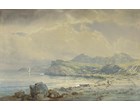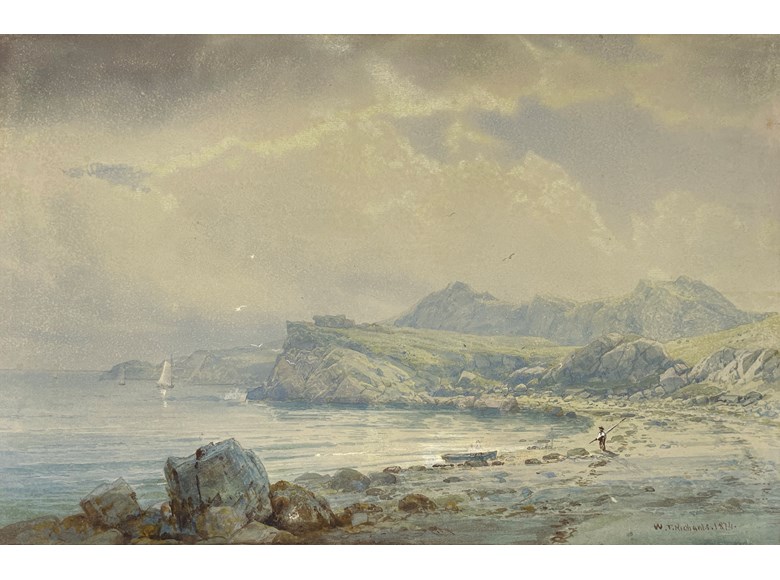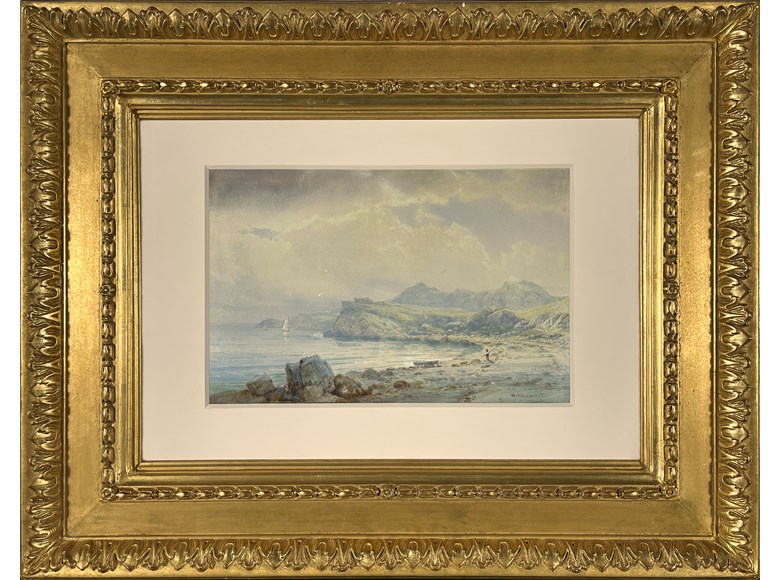 BACK TO GALLERY
BACK TO GALLERY
Avery Galleries
William Trost Richards
Conanicut, Rhode Island
Signed and dated lower right: W. T. Richards. 1874.
8 7/8 x 13 5/8 inches (22.5 x 34.6 cm)
description
During the 1870s, William Trost Richards gained great renown for his masterful watercolors. In fact, Richards stood at the center of the American watercolor movement, creating works that were hailed for their expert technique. Conanicut, Rhode Island, painted in 1874, is an excellent example of one of his watercolors. Here, Richards uses the medium to great effect by alternating between delicate and vigorous brushwork in order to set down all of the detail that so fascinated him.
Watercolor, an exceedingly difficult technique to master, was well-suited to Richards's interest in carefully recording all of the elements of nature, which was a philosophy that stemmed from his study of John Ruskin's aesthetic theory about truth and art. Ruskin held that it was the artist’s duty to strive for absolute truth to nature insofar that traces of the artist’s hand would be virtually effaced from the work. Conanicut, Rhode Island not only satisfies the tenets of this belief, it also demonstrates Richards's masterful handling of his preferred subject: panoramic vistas of the sea.
Early in his career Richards was drawn to painting the coast and sea, and he earned great acclaim as one of the finest and most successful American marine painters. The works he exhibited combined his keen interest in the poetic drama of nature with an unfailing attention to detail. In Conanicut, Rhode Island, Richards's artistic strengths come together to create a dynamic rendering of the landscape he loved.
William Trost Richards was born in Philadelphia and attended Central High School, where such men as Thomas Eakins and Peter A. B. Widener also went to school. His formal education ended at the age of thirteen, as he had to help support his family. Richards trained as a designer of ornamental metalwork and while doing so he also studied draftsmanship and painting under Paul Weber. He probably took art lessons at the Pennsylvania Academy of the Fine Arts, where he first exhibited in 1852. The following year he was elected as a full academician there. In 1855–56 he toured Europe and studied for several months in Düsseldorf, but he eventually grew tired of the contemporary European landscape and returned to Philadelphia.
Richards received a medal at the Centennial Exposition in Philadelphia in 1876, the Temple Medal from the Pennsylvania Academy of the Fine Arts in 1885 and a Bronze Medal at the Paris Exposition in 1889. Richards was a member of the American Water Color Society and an honorary member of the National Academy of Design, where he exhibited from 1861 to 1899. His work is represented in the collections of the Boston Museum of Fine Arts, the Brooklyn Museum, the Newark Museum, Fogg Art Museum of Harvard University, St. Louis Art Museum, the Adirondack Museum, Smithsonian Institution, Cooper-Hewitt Museum, Cleveland Museum of Art, Metropolitan Museum of Art, Vassar College Art Gallery, Corcoran Gallery of Art, the Pennsylvania Academy of the Fine Arts, and the Philadelphia Museum of Art.
Watercolor, an exceedingly difficult technique to master, was well-suited to Richards's interest in carefully recording all of the elements of nature, which was a philosophy that stemmed from his study of John Ruskin's aesthetic theory about truth and art. Ruskin held that it was the artist’s duty to strive for absolute truth to nature insofar that traces of the artist’s hand would be virtually effaced from the work. Conanicut, Rhode Island not only satisfies the tenets of this belief, it also demonstrates Richards's masterful handling of his preferred subject: panoramic vistas of the sea.
Early in his career Richards was drawn to painting the coast and sea, and he earned great acclaim as one of the finest and most successful American marine painters. The works he exhibited combined his keen interest in the poetic drama of nature with an unfailing attention to detail. In Conanicut, Rhode Island, Richards's artistic strengths come together to create a dynamic rendering of the landscape he loved.
William Trost Richards was born in Philadelphia and attended Central High School, where such men as Thomas Eakins and Peter A. B. Widener also went to school. His formal education ended at the age of thirteen, as he had to help support his family. Richards trained as a designer of ornamental metalwork and while doing so he also studied draftsmanship and painting under Paul Weber. He probably took art lessons at the Pennsylvania Academy of the Fine Arts, where he first exhibited in 1852. The following year he was elected as a full academician there. In 1855–56 he toured Europe and studied for several months in Düsseldorf, but he eventually grew tired of the contemporary European landscape and returned to Philadelphia.
Richards received a medal at the Centennial Exposition in Philadelphia in 1876, the Temple Medal from the Pennsylvania Academy of the Fine Arts in 1885 and a Bronze Medal at the Paris Exposition in 1889. Richards was a member of the American Water Color Society and an honorary member of the National Academy of Design, where he exhibited from 1861 to 1899. His work is represented in the collections of the Boston Museum of Fine Arts, the Brooklyn Museum, the Newark Museum, Fogg Art Museum of Harvard University, St. Louis Art Museum, the Adirondack Museum, Smithsonian Institution, Cooper-Hewitt Museum, Cleveland Museum of Art, Metropolitan Museum of Art, Vassar College Art Gallery, Corcoran Gallery of Art, the Pennsylvania Academy of the Fine Arts, and the Philadelphia Museum of Art.








 SEND AN EMAIL
SEND AN EMAIL
 (610) 896-0680
(610) 896-0680